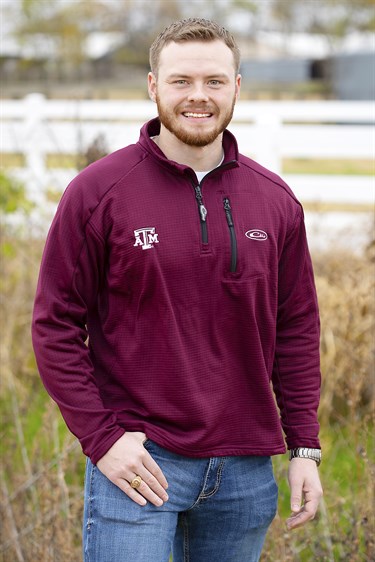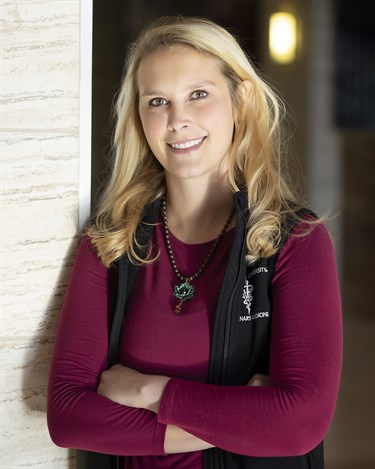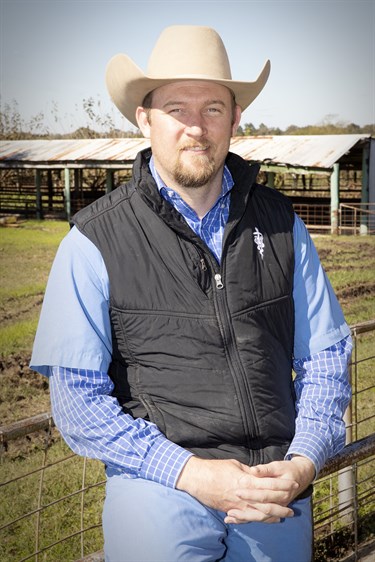Planning to Serve: Veterinary Students Aspire to Practice in Rural Communities
Luke Domas
 Born and raised in Orange, Texas—a small town that runs along the Texas-Louisiana border—Luke Domas grew up on his family’s farm, surrounded by dogs, cats, chickens, horses, rabbits, goats, and a few cows. The desire to be near animals seemed almost innate for Domas, and for as long as he can remember, becoming a veterinarian has been the plan for his future.
Born and raised in Orange, Texas—a small town that runs along the Texas-Louisiana border—Luke Domas grew up on his family’s farm, surrounded by dogs, cats, chickens, horses, rabbits, goats, and a few cows. The desire to be near animals seemed almost innate for Domas, and for as long as he can remember, becoming a veterinarian has been the plan for his future.
“I wanted to be a veterinarian before I could even say the word,” Domas joked. “My mom says that I would say I wanted to be an ‘animal doctor’ when asked what I wanted to be when I grew up. Those feelings stayed the same as I completed high school and entered college.”
With three older siblings, who all attended Texas A&M University, Domas said the choice was a no-brainer when it came time to apply for college.
“Shortly after my oldest sister started at Texas A&M, my entire closet turned maroon with Aggie T-shirts,” he said. “I loved visiting my siblings whenever I could, and I loved getting to attend Midnight Yell, football games, and several events on campus.”
Along with his love for the university and its beloved traditions, Domas said he wanted to attend Texas A&M because of the outstanding reputation of the College of Veterinary Medicine & Biomedical Sciences (CVM). In 2015, Domas received his bachelor’s degree in biomedical sciences and is currently in his fourth year of veterinary school.
“I think the biggest enjoyment I have had while at Texas A&M is knowing that I received a top-notch education,” he said. “Although the long nights of studying were not the most pleasant, it’s nice to look back at what I have accomplished while being here.”
After graduation, Domas would like to get back to his small-town roots and eventually practice mixed animal medicine in a rural community.
“Growing up in a small community, I have seen first-hand how important it is to have access to quality veterinary care,” Domas said. “There is a growing need for good clinicians in rural settings, and I hope to help bridge that gap. Although I love cats, dogs, and other family pets, my strong desire to care for large animals would not be as easily fulfilled in an urban setting.”
As graduation grows nearer and his dreams become reality, Domas is thankful for the invaluable experiences and education he has received while at Texas A&M.
“The additional opportunities provided through the school to travel to outlying locations and care for cattle, equine, and exotic animals during various rotations have given me real-world experiences in a rural setting. Coupled with the experience I gained here working in the hospitals, I feel I have a strong foundation to carry on once I graduate,” he said. “The academic training at A&M and the College of Veterinary Medicine has prepared me to handle a wide variety of cases that I may encounter in the future.”
Taylor Williams
 Taylor Williams, a second-year student in the Texas A&M College of Veterinary Medicine & Biomedical Sciences (CVM), is excitedly awaiting the day she can begin working as a veterinarian in the Texas Panhandle region. Growing up in the Panhandle, Williams noticed a lack of rural veterinarians and decided to do her part in solving this issue by returning home after graduation to start her own mixed animal veterinary practice.
Taylor Williams, a second-year student in the Texas A&M College of Veterinary Medicine & Biomedical Sciences (CVM), is excitedly awaiting the day she can begin working as a veterinarian in the Texas Panhandle region. Growing up in the Panhandle, Williams noticed a lack of rural veterinarians and decided to do her part in solving this issue by returning home after graduation to start her own mixed animal veterinary practice.
“My plan is to serve the need for rural area veterinarians in the Panhandle by offering a variety of services for a variety of species,” she said. “Working in the Panhandle is an attractive option for me because without access to a large referral hospital in that area, I will have the opportunity to work on a variety of species and to be outside of my comfort zone in assisting animals that may otherwise not get veterinary care.”
In addition to the variety of animal species she will care for, Williams is excited to go home.
“I thoroughly enjoy the people in the Panhandle and the amount of passion they have for the livestock they raise,” she said. “It excites me to get to be a part of their livelihood and assist them in their production.”
Williams grew up in Amarillo, where she gained experience in agriculture through FFA, 4-H, and programs sponsored by West Texas A&M (WT). She worked for a local veterinary practice and judged horses while attending WT for her undergraduate education.
“Not only did attending WT allow me to save money, due to low tuition costs and close proximity to my home, but the agriculture department there was also a perfect fit for me,” Williams said.
After graduating from WT, Williams had no doubt that Texas A&M University was where she would go to pursue her veterinary degree.
“Texas A&M was the only school I would consider because of the prestigious reputation it had and the fact that it was located in my home state,” Williams said. “Furthermore, Texas A&M offers the most reputable large animal program I am aware of, and I knew I could gain skills that I could take back to the Panhandle in the future.”
Williams said one of her favorite things about Texas A&M is getting to work with faculty who are more than willing to teach by sharing their experiences.
“In a short amount of time, I have gained an invaluable resource through connections at Texas A&M and lifelong mentors I will be able to keep in touch with even when I am back in the Panhandle,” she said.
She also appreciates that the A&M veterinary program is helping her prepare for a career in working with large animals, which she will often see in the Panhandle.
“The new curriculum contains a surprisingly large amount of large animal material,” she said. “I was not expecting to be given the opportunity to have hands-on large animal experience so early on in veterinary school.”
Once she returns to the Panhandle, Williams plans to help WT pre-veterinary students by offering internships at her veterinary practice. She is excited to serve her community and invest in future veterinarians.
Trent Dozier
 The Aggie War Hymn is not a typical lullaby for babies, but it was for Trent Dozier.
The Aggie War Hymn is not a typical lullaby for babies, but it was for Trent Dozier.
“I was raised as an Aggie and I never really knew there were other options,” he laughed.
Now a class of 2019 Texas A&M University College of Veterinary Medicine & Biomedical Sciences (CVM) student, Dozier is learning veterinary skills in order to one day help the hard-working ranchers of West Texas.
Dozier grew up on his family’s farm helping his father, Dr. Warren Dozier, who is a mobile large animal veterinarian in Fisher County, Texas.
“Growing up, I spent a lot of time working our cattle with my dad, as well as for other producers throughout the area,” Dozier said.
After finishing high school in Trent, Texas, where his graduating class comprised only 13 people, Dozier earned his bachelor’s degree in animal science through courses taken at Cisco College, Blinn College, and finally, Texas A&M.
“I knew that I eventually wanted to apply to veterinary school, and A&M has one of the top veterinary programs in the world,” Dozier said.
After he graduates from the CVM, Dozier plans to move back to West Texas to practice large animal medicine.
He and his wife, Blair, have been married for 10 years and are excited about becoming part of a community where they can raise their two daughters, 5-year-old Wimberley and newborn Waverley.
“There are a lot of good, hard-working families in West Texas that continue to dedicate their lives to keeping agriculture and the western way of life alive,” Dozier said. “It would be a great privilege to work day in and day out with these salt-of-the-earth people to ensure that the livestock and ranching industry continues to endure for generations to come.”
###
Note: This article appears in the Spring 2019 edition of CVM Today.
For more information about the Texas A&M College of Veterinary Medicine & Biomedical Sciences, please visit our website at vetmed.tamu.edu or join us on Facebook, Instagram, and Twitter.
Contact Information: Megan Palsa, Executive Director of Communications, Media & Public Relations, Texas A&M College of Veterinary Medicine & Biomedical Science; mpalsa@cvm.tamu.edu; 979-862-4216; 979-421-3121 (cell)


